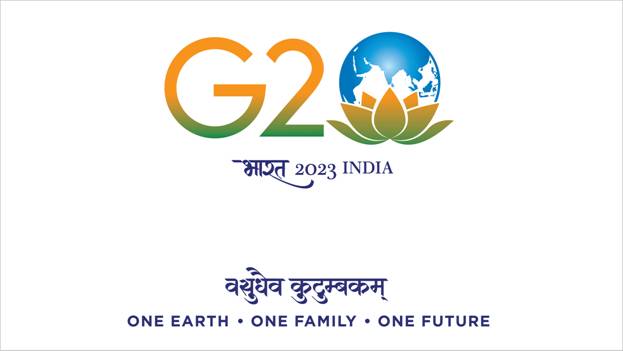
India’s G20 Presidency Theme: “Vasudhaiva Kutumbakam”
- India’s G20 presidency was framed by the theme “Vasudhaiva Kutumbakam,” which translates to “One Earth, One Family, One Future.” This theme draws inspiration from the Maha Upanishad, an ancient Sanskrit scripture.
- The theme underscores the profound interconnectedness of all life forms, including humans, animals, plants, and microorganisms, emphasizing their reliance on Earth and the broader universe.
- It also encapsulates the concept of LiFE (Lifestyle for Environment), promoting environmentally sustainable and responsible lifestyle choices, both at the individual and national levels, to pave the way for a cleaner, greener, and more sustainable future.
India’s G20 Priorities: A Comprehensive Approach India’s G20 presidency centered around several key priorities:
- Green Development, Climate Finance & LiFE: Emphasis on environmental sustainability and responsible living choices.
- Accelerated, Inclusive & Resilient Growth: Promoting growth that is inclusive and resilient, taking into account the needs of all nations.
- Accelerating Progress on SDGs: Focusing on achieving the Sustainable Development Goals.
- Technological Transformation & Digital Public Infrastructure: Embracing technology for development and establishing digital public infrastructure.
- Multilateral Institutions for the 21st Century: Reforming and revitalizing multilateral institutions to meet contemporary challenges.
- Women-led Development: Empowering women in decision-making and socio-economic development.
Working of G20: Tracks of Engagement The G20 operates through two main tracks of engagement:
- The Finance Track: Comprising finance ministers and central bank governors.
- The Sherpa Track: Led by Sherpas, who serve as personal envoys of member nations’ leaders.
Both tracks include working groups that address specific themes and issues with participation from relevant stakeholders.
The Significance of the G20 The G20 emerged in 1999 in response to the late-1990s financial crises, particularly affecting East Asia and Southeast Asia. Its primary objective is to ensure global financial stability, with a particular focus on involving middle-income countries. The G20 collectively represents 60% of the world’s population, 80% of global GDP, and 75% of global trade.
Key Takeaways from the New Delhi Summit
Inclusion of the African Union:
- The African Union (AU), a 55-member bloc, was formally granted permanent membership in the G20, alongside the European Union. Previously, only South Africa was a G20 member from the African continent.
- This move aimed to enhance the representation of the Global South within the G20, countering the historically dominant role of G7 countries.
- It also occurred in the context of expanding BRICs membership, with nations like Saudi Arabia and Iran joining, potentially positioning it as an alternative to the G20.
New Delhi Declaration:
- The New Delhi Leaders’ Summit Declaration was adopted unanimously during the G20 Summit, emphasizing several key priorities set by India.
- These priorities encompassed:
- Sustainable economic growth, inequality reduction, and stability.
- Financial inclusion and the importance of Digital Public Infrastructure (DPI).
- Advancing the Sustainable Development Goals (SDGs) and addressing critical issues like hunger, health, and education.
- Comprehensive commitments to climate action and the implementation of the Paris Agreement.
- Reforms in Multilateral Development Banks (MDBs).
- Empowerment of women through dedicated efforts.
India-Middle East-Europe Economic Corridor:
- India, along with the United States, the UAE, Saudi Arabia, France, Germany, Italy, and the European Union, entered into a Memorandum of Understanding (MoU) to establish the India-Middle East-Europe Economic Corridor (IMEE-EC).
- This economic corridor will encompass rail and port links connecting the Middle East, South Asia, and eventually Europe.
- The IMEE-EC seeks to foster economic integration and presents a strategic challenge to China’s Belt and Road Initiative.
Global Biofuels Alliance:
- Prime Minister Narendra Modi announced the launch of the Global Biofuels Alliance (GBA), which includes 19 countries and 12 international organizations.
- The GBA aims to facilitate global collaboration for the advancement and widespread adoption of biofuels, serving as a central repository of knowledge and expertise.
Differing Views on Ukraine:
- The G20 Summit witnessed varying perspectives on the Ukraine conflict, with the New Delhi Declaration avoiding direct criticism of Russia.
- While the declaration denounced the use of force for territorial gain, it refrained from naming Russia explicitly, in contrast to previous statements that called for Russia’s withdrawal from Ukraine.
In conclusion, India’s G20 presidency and the New Delhi Summit were marked by significant achievements and a commitment to addressing global challenges collectively. The inclusivity of the African Union, the comprehensive New Delhi Declaration, and strategic initiatives like the IMEE-EC and GBA reflect the G20’s evolving role in shaping the world’s economic and political landscape. India’s presidency contributed to the G20’s mission of fostering global cooperation and sustainable development for the well-being of all nations.

